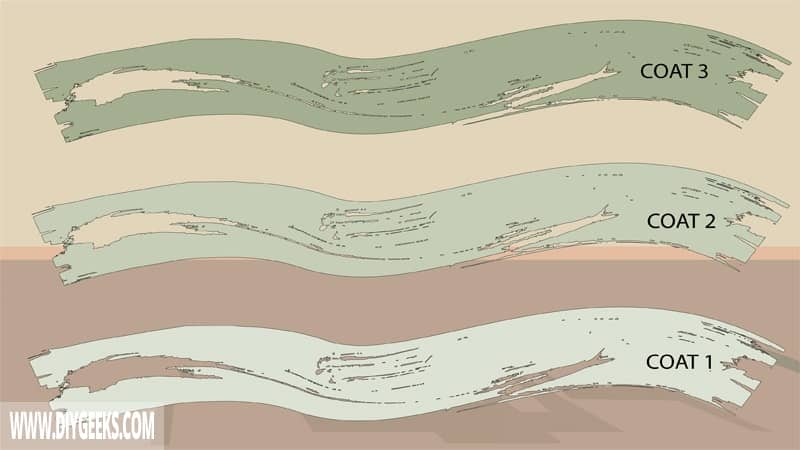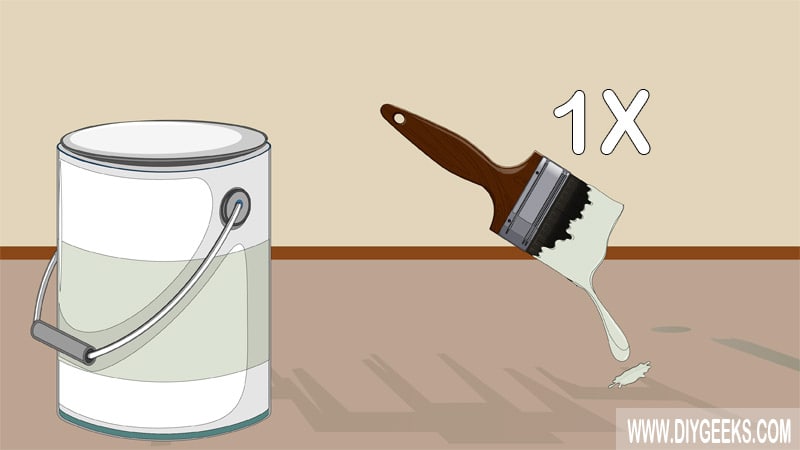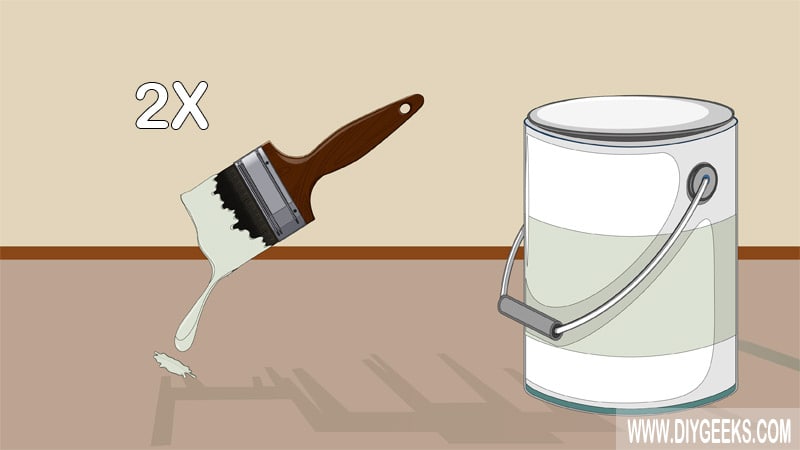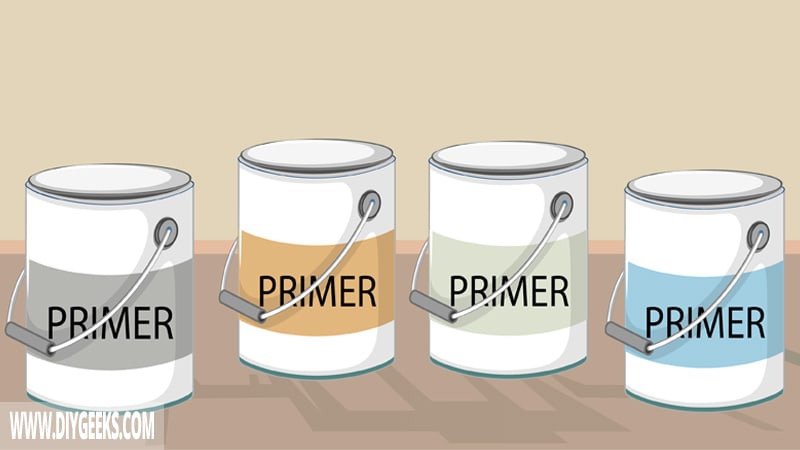You need between 2-3 primer coats over bare surfaces that aren’t painted, and between 1-2 primer coats over surfaces that are already painted or sealed.
The number of coats matters as it determines the finish coverage and thickness. The primer purpose is to cover the existing finish or surface texture, and create a layer that enhances paint penetration and adhesion.
Perfect surfaces (have no imperfections), don’t require too many coats. While surfaces riddled with imperfections require more coats to cover the imperfections or holes it has.
Why Does The Number of Primer Coats Matter?

The number primer coats matters as it determines the coverage, thickness of the finish, and whether the old coating will bleed through.
Fewer coats of primer won’t cover the surface and imperfections properly — this can affect the quality of the finish.
If the surface isn’t covered properly, the old finish (if any) will bleed through the new finish. The existing finish, grease, oils, stains, and dirt, will all bleed through and stain the new finish.
Too many coats of primer will produce a thick finish and this will increase its dry time and make the surface uneven — some parts will dry while others will remain wet. A thick coating is also prone to cracks, and bubble formation, and might peel off.
Note: Sometimes you can apply fewer layers. For instance, if you are painting over a smooth and non-porous surface, one layer of basecoat is enough.
When Should You Apply One Primer Coat Only?

You should apply one primer coat for the following scenarios.
1. If Using Paint & Primer in One
The Paint & Primer product has both, paint and primer in its formula — so you need one (1) coating of it only.
You can apply a second coating only if you are painting over a dark color shade or a surface with lots of imperfections.
2. If Painting Over Light Colors
You need only one (1) primer coat if you are painting over an existing finish with a light shade color.
For instance, if are painting over a white or grey finish, use a primer with the same color and apply one coat only.
Light colors don’t have a lot of pigments so the paint won’t bleed-through.
3. If Painting Over Old Paint
You need one (1) primer if you are painting over an existing finish. The existing paint fills all the imperfections and acts as a base coat for the next coatings.
How To Know If You Need a Second Primer Coat?

To know if you need a second primer coat, check the instructions on the container, and inspect the finish.
The number of required layers will be indicated on the container or user’s guide. Also, If the finish is rough, heavily colored, and hasn’t properly covered the full surface, you need another layer.
Here are some other cases:
Wet, Stained, Or Filthy Surface
You need at least two coats of primer if painting over wet, stained, or filthy surfaces to properly cover (block) them from affecting the finish.
Dark or Bright Colors
You need two (2) layers of primer to properly cover dark or bright colors, especially if you want to change the color shade of the finish.
If you don’t properly cover the existing finish, it may bleed through the new finish and stain it.
Tip: To cover dark paints, use a grey primer.
Porous Surface
Porous surfaces, such as wood, absorb more liquid than needed. So, you must properly seal them to prevent them from over-absorbing paint. So, you need to apply two coats of primer over the porous surface to properly seal them.
Repaired Surface
For surfaces that have just been repaired, you must apply two layers of primer to seal the imperfections and holes in the surface.
Also, it’s common to use concrete paste, caulk, polish, wood filler, and the likes on surfaces while repairing them. These compounds contain chemicals that can bleed-through and affect the finish. So you surely need more than one layer of basecoat.
Old or Fresh Wood
Old wood or furniture will most likely be affected by pests like termites and bugs. These pests would have damaged the wood by biting and drilling holes in the wood. So you’ll need at least two layers of primer to cover these holes or imperfections.
Also, fresh wood usually contains tannins and oils that can bleed-through and affect the finish. So you need at least two to three layers of a stain-blocking and moisture-resistant primer.
How Many Coats Of Primer Based On The Color?

You need 1-2 primer coats if painting over light color finishes, and 2-3 primer coats if painting over dark finishes.
Light colors are not heavily pigmented so it’s easier to cover them with just one coat. Also, light colors are neutral which means they won’t affect the color of the finish.
Dark finishes are deep and contain more paint pigments than light paints. As such, it’s more difficult to cover the color or prevent it from bleeding through the finish, so you need more coats.
If the surface is defective, moist, or stained, you’ll need to repair it first. Without doing that, you’ll need many coats of primer to first seal the imperfections on the surface and then more coats to cover the dark paint. This will cause you to apply too many coats and ruin the finish.
You need at least two layers of basecoat for bright or vibrant colors, such as red, yellow, or orange. This is because these paints contain a high volume of paint colorants which produces a bright finish. So you’ll need more layers of basecoat to cover and prevent the bright color from showing underneath the finish.
If you are painting over a surface with the same color shade, you need one coat only.
Related Read: What Primer Color Should You Use?
How Many Coats Of Primer For Different Surfaces?
The number of coats for different surfaces is listed below.
Wood
You need two (2) primer coats over wooden surfaces.
Wooden surfaces are porous and absorb too much paint, so you must seal them with a primer to prevent over-absorption.
You need three coats of primer if the wooden surface is damaged as you must cover the imperfections (cracks, holes) that can affect the quality of the finish,
New Drywall
You need two primer coats over drywall surfaces.
Drywall surfaces are porous and the first coat of primer will be absorbed so you need a second coat to properly cover and seal the imperfections.
You need more than two (2) coats of primer for fresh drywalls.
Metal
You need two (2) spray primer coats for outdoor metal since the surface is exposed to weather elements. You need one (1) coat of primer for indoor metal surfaces.
Spray primer will prevent oxidization on the outdoor metal surface which can cause rust.
If the metal already contains compounds that prevent oxidization, you don’t need to apply a base coat.
Kitchen Cabinets
You need two (2) thick primer coats over kitchen cabinets as they are exposed to moisture, steam, heat, and constant friction.
MDF
You need one (1) primer coat over MDF and other furniture as these surfaces are usually placed indoors and are shielded from weather elements. MDF surfaces aren’t heavily used and don’t need much protection.
For outdoor MDF surfaces, you need two (2) coats of primer.
Concrete
You need two (2) epoxy primer coats over concrete surfaces because they are rough and uneven. Two coats will properly cover the imperfection and create a smooth layer for the paint to stick to.
Plastic
You need one (1) primer coat over plastic surfaces as they are non-porous. Applying more than 1 coat will make the finish too thick.
[sc name=”primer-coat-number”][/sc]


